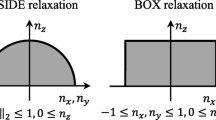Abstract
Many different algorithms for surface mesh optimization (including smoothing, remeshing, simplification and subdivision), each giving different results, have recently been proposed. All these approaches affect vertices of the mesh. Vertex coordinates are modified, new vertices are added and some original ones are removed, with the result that the shape of the original surface is changed. The important question is how to evaluate the differences in shape between the input and output models. In this paper, we present a novel and versatile framework for analysis of various mesh optimization algorithms in terms of shape preservation. We depart from the usual strategy by measuring the changes in the approximated smooth surfaces rather than in the corresponding meshes. The proposed framework consists of two error metrics: normal-based and physically based. We demonstrate that our metrics allow more subtle changes in shape to be captured than is possible with some commonly used measures. As an example, the proposed tool is used to compare three different techniques, reflecting basic ideas on how to solve the surface mesh improvement problem.











Similar content being viewed by others
References
Strang G, Fix GJ (1973) An analysis of the finite element method. Prentice Hall, Englewood Cliffs
Hoppe H, Duchamp T, McDonald J, Stuetzle W (1993) Mesh optimization. In: Computer graphics (SIGGRAPH’93) pp 19–26
Surazhsky V, Gotsman C (2003) Explicit surface remeshing. In: Proceedings of eurographics symposium on geometry processing, pp 17–28
Alboul L, van Damme R (1997) Polyhedral metrics in surface reconstruction: tight triangulations, the mathematics of surfaces VII. Clarendon Press, Oxford, pp 309–336
Dyn N, Hormann K, Kim S-J, Levin D (2001) Optimizing 3D triangulations using discrete curvature analysis, mathematical methods for curves and surfaces. Vanderbilt University Press, Innovations in Applied Mathematics Series, pp 135–146
Garimella RV, Shashkov MJ, Knupp PM (2004) Triangular and quadrilateral surface mesh quality optimization using local parameterization, Comput Meth Appl Mech Eng 193(9–11):913–928
Frey P, Borouchaki H (1998) Geometric surface mesh optimization. Computer and Visualization in Science, pp 113–121
Knupp PM (2000) Achieving finite element mesh quality via optimization of the Jacobian matrix norm and associated quantities. Int J Numer Meth Eng 48:401–420
Heckbert PS, Garland M (1997) Survey of polygonal surface simplification algorithms. In: SIGGRAPH’97 course notes: multiresolution surface modeling
Loop C (1987) Smooth subdivision surfaces based on triangles. Master’s thesis. University of Utah, Department of Mathematics
Dyn N, Levin D, Gregory JA (1990) A butterfly subdivision scheme for surface interpolation with tension control. ACM Trans Graph 9(2):160–169
Zorin D, Schroder P, Sweldens W (1996) Interpolating subdivision for meshes with arbitrary topology. In: SIGGRAPH’96, conference proceedings, pp 189–192
Cignoni P, Rocchini C, Scopigno R (1998) Metro: measuring error on simplified surfaces. Comput Graph Forum 17(2):167–174
Belyaev A, Ohtake Y (2003) A comparison of mesh smoothing methods. In: Israel-Korea bi-national conference modeling and computer graphics, pp 83–87
Karbacher S, Seeger S, Hausler G (2000) A non-linear subdivision scheme for triangle meshes. In: Vision, modeling and visualization 2000, pp 163–170
Karbacher S, Seeger S, Hausler G (2001) Refining triangle meshes by non-linear subdivision. In: Proceedings of 3rd international conference on 3D digital imaging and modeling, IEEE Computer Society, pp 270–277
Anoshkina EV, Belyaev AG, Seidel H-P (2002) Asymptotic analysis of three-point approximations of vertex normals and curvatures. In: Vision, modeling, and visualization 2002, pp 211–216
Vlachos A, Peters J, Boyd C, Mitchell JL (2001) Curved PN triangles, In: Symposium on interactive 3D graphics, pp 159–166
Floater MS (1997) Parameterization and smooth approximation of surface triangulation. Comput Aid Geomet Des 14:231–250
Hormann K, Lasik U, Greiner G (2001) Remeshing triangulated surface with optimal parameterization. Comput Aid Des 33(11):779–788
Canann SA, Tristano JR, Staten ML (1998) An approach to combined Laplacian and optimization-based smoothing for triangular, quadrilateral, and quad-dominant meshes. In: Proceedings of the 7th international meshing roundtable, pp 479–494
Semenova I, Savchenko V, Hagiwara I (2004) Two techniques to improve mesh quality and preserve surface characteristics. In: Proceedings in 13th international meshing roundtable, pp 277–288
Semenova I, Savchenko V, Hagiwara I (2004) Improvement of triangular and quadrilateral surface meshes. In: Proceedings in the 14th international conference on computer graphics and vision (GraphiCon’2004), pp 79–87
Author information
Authors and Affiliations
Corresponding author
Rights and permissions
About this article
Cite this article
Semenova, I., Kozhekin, N., Savchenko, V. et al. A general framework for analysis and comparison of surface mesh optimization techniques. Engineering with Computers 21, 91–100 (2005). https://doi.org/10.1007/s00366-005-0305-y
Received:
Accepted:
Published:
Issue Date:
DOI: https://doi.org/10.1007/s00366-005-0305-y




